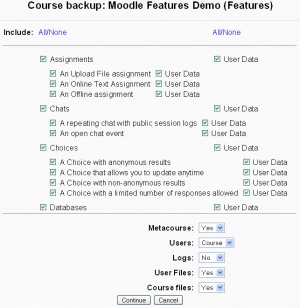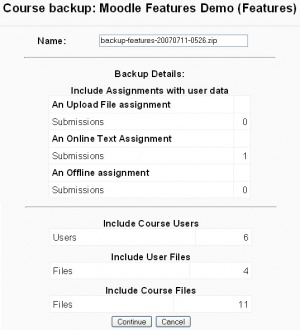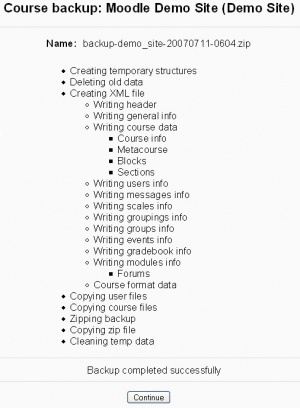Course backup: Difference between revisions
No edit summary |
|||
| (52 intermediate revisions by 14 users not shown) | |||
| Line 1: | Line 1: | ||
{{Course admin}}<p class="note">'''Note:''' Backup and restore has been completely rewritten for Moodle 2.0. See [[Backup 2.0]] for details.</p> | |||
A course can be saved with some or all of its parts by using the course backup. Typically, the site administrator will set a schedule of [[Automated course backup|automated course backups]] for the whole site. A teacher with editing privileges can create a backup or download an existing backup for safe keeping, or for use on another Moodle site. | |||
==Creating a course backup== | |||
[[Image:Course_backup.jpg|thumb|Creating a course backup - page 1]][[Image:Course_backup_s2.jpg|thumb|Creating a course backup - page 2]][[Image:Course_backup_s3.jpg|thumb|Creating a course backup - page 3]] | |||
To create a course backup: | |||
#Click Backup in the [[Course administration block]]. | |||
#Select your backup options (Page 1) | |||
##Choose the activities and resources you want to include, the default is everything. | |||
##*The Include All/None links at the top will check or uncheck all the boxes in a column. | |||
##*Use the individual boxes to select or unselect specific parts of the course for the backup. | |||
##Select course options desired at the bottom (see Backup options below) | |||
#Click the Continue button to start the backup process. | |||
#On the next page (Page 2) | |||
#*You can edit the default backup filename at the top of this page (uses format:backckup-COURSESHORTNAME-DATE-TIME.zip). | |||
#*You will see the backup details, a list of files and user data that Moodle will include in the backup | |||
#Click the Continue button at the bottom. Or if this does not look right, use cancel to exit the backup process or use your back browser arrow to return to the initial course backup page. | |||
#On the next page (Page 3), the progress of the backup is displayed. | |||
#*You should see the message "Backup completed successfully" at the bottom of the page. | |||
#Click the Continue button. | |||
#You will then be taken to the backupdata directory (see page 4).[[Image:Backupdirectory.png|200px|thumb|backupdata directory - page 4]] | |||
#*You may click on a filename to download any backup file to your computer. | |||
#*Later this area can be reached by the Course administration block by using the Restore link or looking for what is usually called the backupdata folder under the Files link. | |||
==Backup options== | |||
* Metacourse - If you are backing up the content of a [[Metacourses|metacourse]], you may enable this option so that relations between the courses will be exported and the restore process will try to rebuild them in the destination server. | |||
* Course files - This backs up any file stored in the [[Files|files]] area for the course | |||
* Backup role assignments for these roles - This setting provides a way of copying a custom role from one Moodle site to another. See 'How do I copy a custom role from one Moodle site to another' in [[Roles FAQ]] for details. | |||
==Backup of user data== | |||
Users with the capability [[Capabilities/moodle/backup:userinfo|moodle/backup:userinfo]] (by default only admins) have the following additional backup options: | |||
* User data - This backs up all student files, submissions, forum postings, glossary entries, etc. | |||
* Users - Whether you want to backup the content concerning course students or no students at all. By selecting "none", the backup process will not backup user data. Users with the capability [[Capabilities/moodle/site:backup|moodle/site:backup]] in the system context have the additional option to backup all users on the site. | |||
* Logs - This backs up all [[Reports|course activity logs]] | |||
* User files - This backs up all user pictures | |||
''Note'': In Moodle 1.8.11 and 1.9.7 onwards, hashed user passwords are no longer saved in backup files containing user data. If a backup is restored to a new site, users will be asked to go through the "forgot my password" routine the first time they log in. | |||
==Creative uses== | |||
The backup and restore processes can offer the teacher and administrators many creative solutions. | |||
*Duplicating courses or specific activities in one course to another course (similar to Import) | |||
*Updating a production Moodle site course, with material from a localhost site course | |||
*Transferring a course to a new Moodle site. | |||
*In earlier versions of Moodle, a way of rolling a course forward without past student activity | |||
*Creating a blank activity, save just that activity and then restore it to the course or another course one or more times. | |||
==See also== | |||
*[[Course restore]] | |||
*[[Automated course backup]] - for administrators | |||
*[[Backup and restore FAQ]] | |||
*[[Roll courses forward]] | |||
*[[Front Page]] trick to backup Front page in earlier version of Moodle | |||
*[http://www.youtube.com/watch?v=ZrdM_KOr530 Creating course backups video] | |||
*[http://knol.google.com/k/art-lader/moodle-avert-a-disaster/10r7i4g9er58l/1# Google Knol article] - this page no longer available but you can access a copy via the [http://web.archive.org/web/20110721000702/http://knol.google.com/k/moodle-avert-a-disaster# Wayback Machine Internet Archive] | |||
*Using Moodle [http://moodle.org/mod/forum/discuss.php?d=59581 Location of Backup Files] forum discussion | |||
[[Category:Backup]] | |||
[[ca:backup/backup]] | |||
[[de:Kurssicherung]] | |||
[[es:Copia de Seguridad del Curso]] | |||
[[eu:Ikastaroaren_Segurtasun-kopia]] | |||
[[fr:Sauvegarde de cours]] | |||
[[ja:コースバックアップ]] | |||
Latest revision as of 06:31, 24 August 2012
Note: Backup and restore has been completely rewritten for Moodle 2.0. See Backup 2.0 for details.
A course can be saved with some or all of its parts by using the course backup. Typically, the site administrator will set a schedule of automated course backups for the whole site. A teacher with editing privileges can create a backup or download an existing backup for safe keeping, or for use on another Moodle site.
Creating a course backup
To create a course backup:
- Click Backup in the Course administration block.
- Select your backup options (Page 1)
- Choose the activities and resources you want to include, the default is everything.
- The Include All/None links at the top will check or uncheck all the boxes in a column.
- Use the individual boxes to select or unselect specific parts of the course for the backup.
- Select course options desired at the bottom (see Backup options below)
- Choose the activities and resources you want to include, the default is everything.
- Click the Continue button to start the backup process.
- On the next page (Page 2)
- You can edit the default backup filename at the top of this page (uses format:backckup-COURSESHORTNAME-DATE-TIME.zip).
- You will see the backup details, a list of files and user data that Moodle will include in the backup
- Click the Continue button at the bottom. Or if this does not look right, use cancel to exit the backup process or use your back browser arrow to return to the initial course backup page.
- On the next page (Page 3), the progress of the backup is displayed.
- You should see the message "Backup completed successfully" at the bottom of the page.
- Click the Continue button.
- You will then be taken to the backupdata directory (see page 4).
- You may click on a filename to download any backup file to your computer.
- Later this area can be reached by the Course administration block by using the Restore link or looking for what is usually called the backupdata folder under the Files link.
Backup options
- Metacourse - If you are backing up the content of a metacourse, you may enable this option so that relations between the courses will be exported and the restore process will try to rebuild them in the destination server.
- Course files - This backs up any file stored in the files area for the course
- Backup role assignments for these roles - This setting provides a way of copying a custom role from one Moodle site to another. See 'How do I copy a custom role from one Moodle site to another' in Roles FAQ for details.
Backup of user data
Users with the capability moodle/backup:userinfo (by default only admins) have the following additional backup options:
- User data - This backs up all student files, submissions, forum postings, glossary entries, etc.
- Users - Whether you want to backup the content concerning course students or no students at all. By selecting "none", the backup process will not backup user data. Users with the capability moodle/site:backup in the system context have the additional option to backup all users on the site.
- Logs - This backs up all course activity logs
- User files - This backs up all user pictures
Note: In Moodle 1.8.11 and 1.9.7 onwards, hashed user passwords are no longer saved in backup files containing user data. If a backup is restored to a new site, users will be asked to go through the "forgot my password" routine the first time they log in.
Creative uses
The backup and restore processes can offer the teacher and administrators many creative solutions.
- Duplicating courses or specific activities in one course to another course (similar to Import)
- Updating a production Moodle site course, with material from a localhost site course
- Transferring a course to a new Moodle site.
- In earlier versions of Moodle, a way of rolling a course forward without past student activity
- Creating a blank activity, save just that activity and then restore it to the course or another course one or more times.
See also
- Course restore
- Automated course backup - for administrators
- Backup and restore FAQ
- Roll courses forward
- Front Page trick to backup Front page in earlier version of Moodle
- Creating course backups video
- Google Knol article - this page no longer available but you can access a copy via the Wayback Machine Internet Archive
- Using Moodle Location of Backup Files forum discussion



